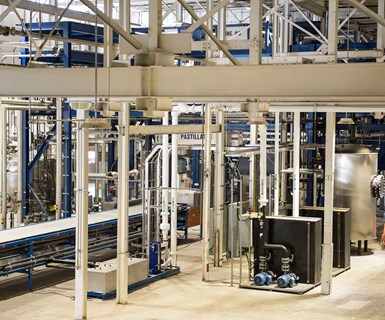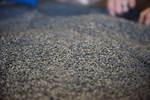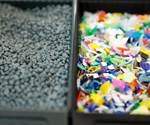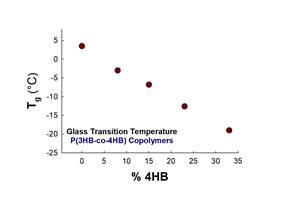Transforming Recycled Plastic into Additives for Industrial and Consumer Products
GreenMantra out of Canada is a rapidly growing clean technology company that produces specialty polymer additives from recycled plastics.
With a more increased focus on adding more recycled content to products, it’s becoming very apparent that innovation is required in order to meet these demands. During the Plastics Recycling Conference, Canadian cleantech company GreenMantra Technologies accepted the Association of Plastics Recyclers (APR) Showcase Award, which is given to companies who have a innovative and potentially game-changing idea to advance the recycling of plastics.
During the conference, Plastics Technology México Editor-in-Chief Natalia Ortega and I sat down with Domenic Di Mondo, Vice President Technology and Business Development, to learn more about this growing company.

Inside GreenMantra’s facility in Brantford, Ontario.
GreenMantra Technologies is a clean technology company that utilizes a proprietary catalyst and patented depolymerization process to upcycle and transform recycled plastics into value-added synthetic waxes and specialty polymers.
“As a company, we started in 2010. At that point, we had a concept of the technology. This was the origin of the term ‘chemical recycling’ that people are using now, which is also referred to as ‘advanced recycling,’” Di Mondo said. “It's very basically defined as technologies that change the structure of plastic or do something on a more molecular level, as opposed to just remelting [as with mechanical recycling]. That's the core of the technology we developed.”
The company started in 2010 and built a lab process that they validated and then took to a demonstration scale. They are reportedly the first company in the world to upcycle post-consumer and post-industrial recycled plastics into synthetic polymers and additives that meet specific performance requirements for industrial applications. Utilizing its proprietary thermo-catalytic system and patented process, GreenMantra transforms recycled plastics into value-added waxes and specialty polymers for industrial applications such as roofing, roads, plastic composites and polymer processing.
“We're redesigning the molecule to create these new specialty polymers,” Di Mondo said. “What's interesting is it allows us to take these non-uniform, discarded plastics and make a very uniform high-quality synthetic wax that actually has novel applications.”
Scaling Production
GreenMantra is growing rapidly and expanding its manufacturing facilities in Brantford, Ontario to meet demand for performance additives.
Since 2016, GreenMantra been operating facilities 24/7 and making large quantities of products that are going out into markets across North America. And now this year, they’re expanding their commercial footprint into Europe as well.

GreenMantra’s synthetic wax might look similar to a plastic pellet, but the properties are radically different.
DiMondo explained the process as this:
“We take the discarded plastics and produce an end product that is a synthetic wax. We do that with both polyethylene and polypropylene on a commercial scale. So it actually comes out of our process, looking similar to pellets of plastic, but the properties are completely different from the starting material. That allows us to create a novel raw material that other manufacturers use in their process as a performance-enhancing additive.”
For the first eight years, the company was focused on working with polyethylene and polypropylene and when it saw success, it wanted to push the boundaries of its technology. About two years ago, the company introduced new technology around waste polystyrene.
“We asked ourselves, ‘can we do something with polystyrene?’ since this waste stream is essentially going to landfill and doesn't have a great outlet. We built a technology to do the same kind of thing,” he said. “But instead of making synthetic waxes [as we do with polyethylene and polypropelene], we make very novel styrenic polymers. This opens up the door to a whole new set of applications and end customers. It allowed us to diversify the portfolio further and to extend our platform and technology.”
Last year, the company announced a partnership with Ineos Styrolution that will align GreenMantra’s patented technology and Ineos Styrolution’s manufacturing infrastructure to convert waste polystyrene into chemical monomer building blocks.
GreenMantra purchases the discarded plastic by leveraging the existing mechanical recycling network in North America and also working with processors.
Di Mondo said that the company works with different Consumer Packaged Goods (CPGs) on ways to help them use more recycled content.
“We’ll ask, ‘okay, what's the challenge you're facing --- is it putting traditional recycled content in the bottle, in the bag, or in the container?’ If the issue is performance or a negative impact on process efficiency, (which reduces the output and increases the overall cost for manufacturers), that's where we can come in and say, ‘okay, we have an additive that you can use at 1 to 4 percent, which is exciting because that in and of itself counts as recycled plastic. But on top of that, it also gives you that ‘multiplier effect’. Now you can put in that 40 percent recycled plastic instead of virgin, and not have to worry about losing 20% in your output or making inferior products.”
Related Content
Compatibilizers Aid Recycling & Upcycling of Mixed Resins
Compatibilizers are proving their worth in boosting critical properties such as impact/stiffness balance of PCR and PIR blends of polyolefins and other plastics.
Read MoreHow to Optimize Injection Molding of PHA and PHA/PLA Blends
Here are processing guidelines aimed at both getting the PHA resin into the process without degrading it, and reducing residence time at melt temperatures.
Read MoreFilm Extrusion: Boost Mechanical Properties and Rate of Composting by Blending Amorphous PHA into PLA
A unique amorphous PHA has been shown to enhance the mechanical performance and accelerate the biodegradation of other compostable polymers PLA in blown film.
Read MoreRecycling: What's Ahead in Advanced Sorting Technology
As the industry tries to ramp up recycling, there are several innovative sorting solutions in the offing—ranging from enhanced optical sorting technologies and chemical tracers to advanced solutions based digital watermarks and artificial intelligence.
Read MoreRead Next
PP Waxes with Unique & Customizable Technical Properties
GreenMantra’s new PP waxes are among the high-value products from waste plastics it makes.
Read MoreWhat Is the Circular Economy?
In this video from K 2019, hear NOVA Chemicals, TOMRA, Covestro, Rapid Granulator and SABIC each discuss plastics’ role in the circular economy.
Read More
























